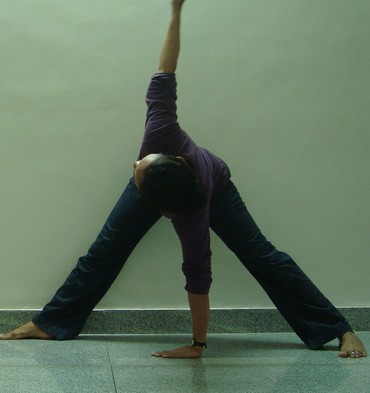 | « Back to article | Print this article |
Yoga to tone your body, build stamina and stay young
The triangle pose or the trikonasana is a fabulous way to health. It has many variations and each challenging in its own way. The basic pose itself challenges several systems in our body, including the nervous system.
Though an advanced yoga practice requires you to stay in a classic pose for longer duration, you must also use advanced variations of such classic poses to challenge other muscles group. Once a pose has been mastered and practiced for long it becomes easy for the body.
The muscles actually become 'bored' with the lack of challenge. Which may explain why some yoga practitioners remain unshapely despite several years of practice: it comes from their resistance to try advanced variation and getting cocooned in a comfortable, unchallenging practice.
This may guarantee moderate health, but does not vault you into a state of super vitality which comes with a more dedicated or adventurous yoga practice.
The trikonasana (translating to mean triangle pose) is a complete pose. It makes you look down, and thus resembles an inversion.
Inversions are superb way to remain young.
It involves spinal twist, which gives the spine a transverse traction. It also challenges both arms and legs, inviting tone. If duration in the final pose is extended, it also builds mental and physical stamina. It also challenges the balance, especially in its advanced variation, thus tweaking the cerebellum.
This also has a powerful effect on the nervous system, especially impulse control or addictive behaviour patterns.
Shameem Akthar, yogacharya, trained with Trivandrum's Sivanananda Yoga Vedanta Centre, gives you five variations of the triangle pose, which will help you progress from the basic to its advanced variation.
For more of Shameem's yoga writings visit http://jaisivananda.blogspot.com. Follow Shameem's yoga products on her online shop Yogatique on Rediff Shopping here. Shameem's second book Yoga in the workplace, with photographs by ace photographer Fawzan Husain, is now available at online shops and bookshops across the country.
Disclaimer: This column just shares the columnist's passion for yoga, which is ideally learned under the guidance of an expert.
Trikonasana (Triangle): Simple Version
Stand up straight. Spread legs, feet a meter or so apart. Point right foot ahead. Left foot is lightly turned inward. Hands out at shoulder level. Inhale. Exhale, twist to the right.
Place left hand on the right knee. Right hand lifts up, straight. Look at right hand. Hold the pose, breathing normally. Ensure legs are straight. Hold for ten seconds. Release pose, to repeat for other side. You may also do each side three times for better impact and building stamina.
Benefits: Is therapeutic in most diseases. Used as therapy in knee problems. Tones body. Builds stamina. Is said to stimulate the mind, removing lethargy.
Trikonasana (Triangle): Basic version
Stand up straight. Spread legs, feet a meter or so apart. Point right foot ahead. Left foot is lightly turned inward. Hands out at shoulder level. Inhale. Exhale and twist to right side.
Place left hand on the ground, between the legs, so that it is centrally placed. Raise right hand. Both hands should form a straight line.
Hold for ten seconds or so, breathing normally. Keep looking at the raised hand. Release the pose. Repeat for other side. Again, may be done thrice each side if you wish to grow in the pose.
Benefits: Same as above, more enhanced.
Trikonasana (Triangle pose): Advanced Version 1
Stand up straight. Spread legs, feet a meter or so apart. Point right foot ahead.
Left foot is lightly turned inward. Hands out at shoulder level. Inhale. Exhale and twist to right side. Left hand is placed on the floor beside right foot.
The closer the hand position, more challenging the stretch. Look up at raised hand. Continue normal breathing throughout. Hold for ten seconds. Release and repeat for the other side. Attempt this version only after perfecting the simple and basic version.
Benefits: The legs are more stretched. The weight also transfers to the legs, so they become stronger. Balance is more challenged, enhancing emotional culturing.
Trikonasana (Triangle pose): Advanced version 2
Stand up straight. Spread legs, feet a meter or so apart. Point right foot ahead. Left foot is lightly turned inward. Hands out at shoulder level. Inhale. Exhale and twist to right side. Left hand is placed on the right ankle. Look up at raised hand.
Continue normal breathing throughout. Hold for ten seconds. Release and repeat for the other side. Attempt this version only after perfecting the simple and basic version.
Benefits: As above, more enhanced.
Trikonasana (Triangle pose): Advanced version 3
Stand up straight. Spread legs, feet a meter or so apart. Point right foot ahead. Left foot is lightly turned inward. Hands out at shoulder level. Inhale. Exhale and twist to right side. Pass the left hand over right leg, placing hand on the floor beside right foot. Hand should have crossed the foot to do this (See image).
Look up at raised hand. Continue normal breathing throughout. Hold for ten seconds. Release and repeat for the other side. Attempt this version only after perfecting the simple and basic version.
Benefits: As above, more enhanced.





